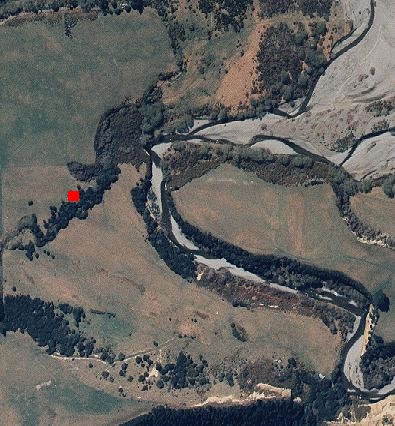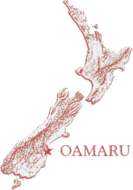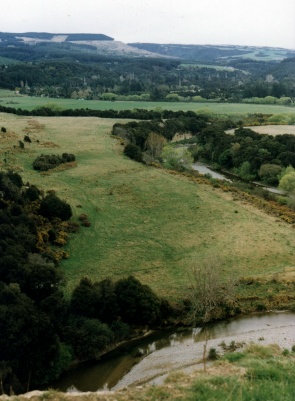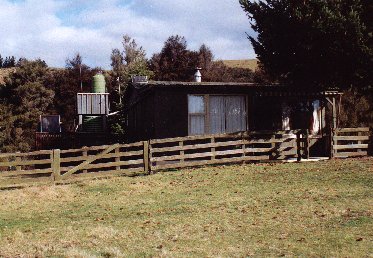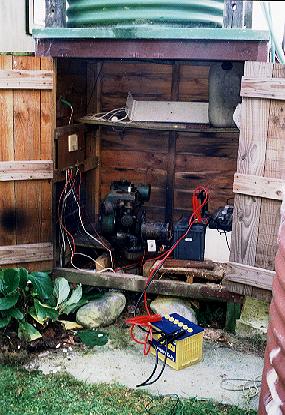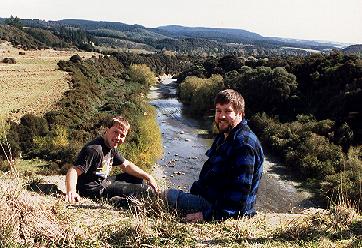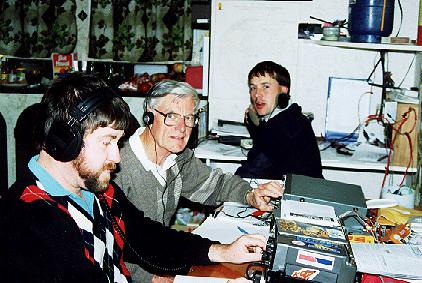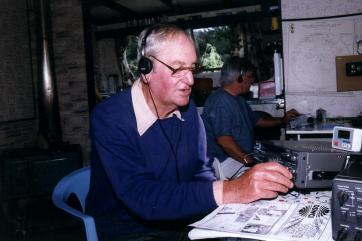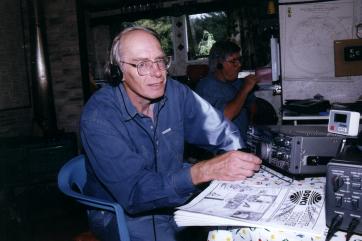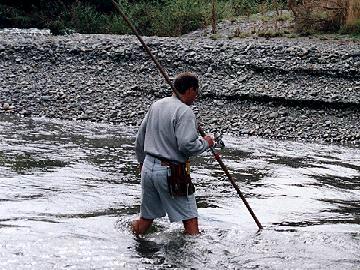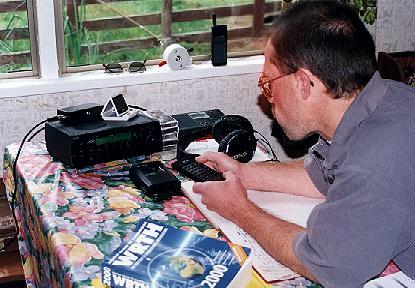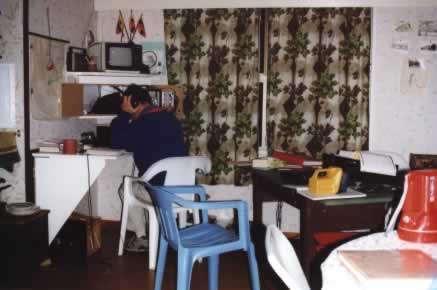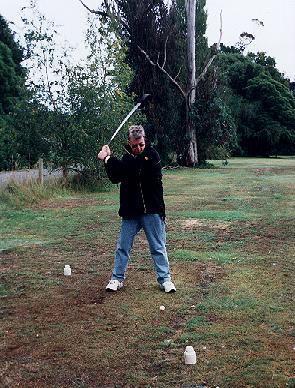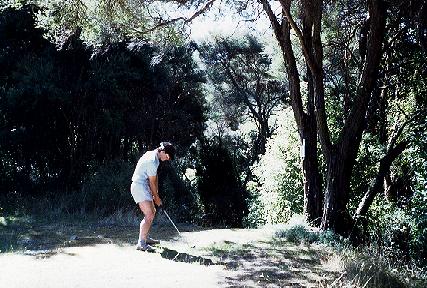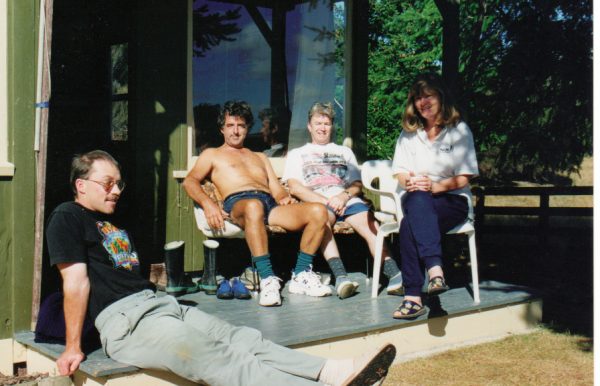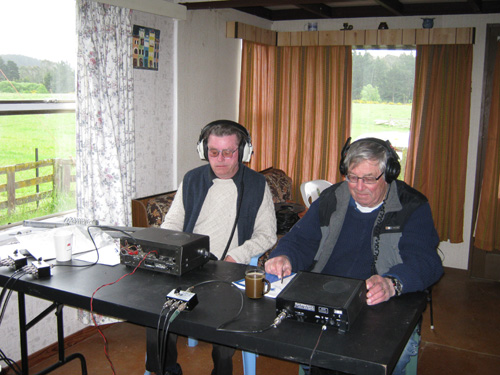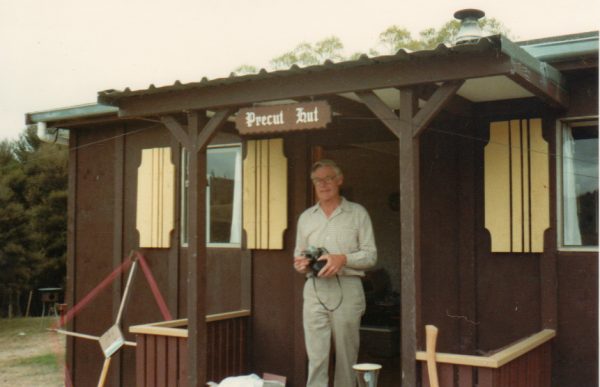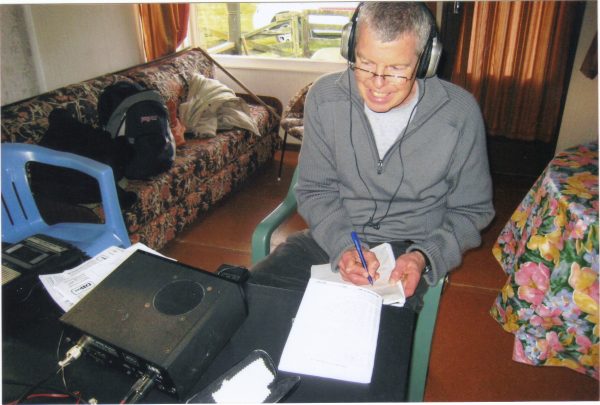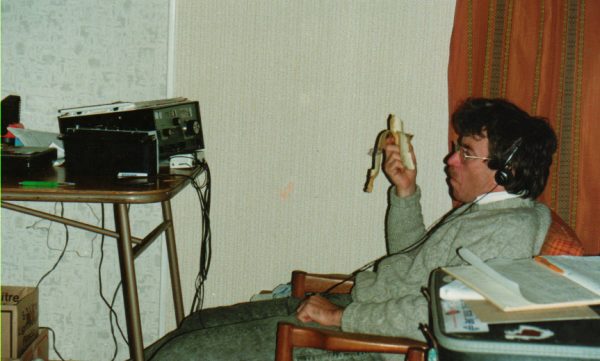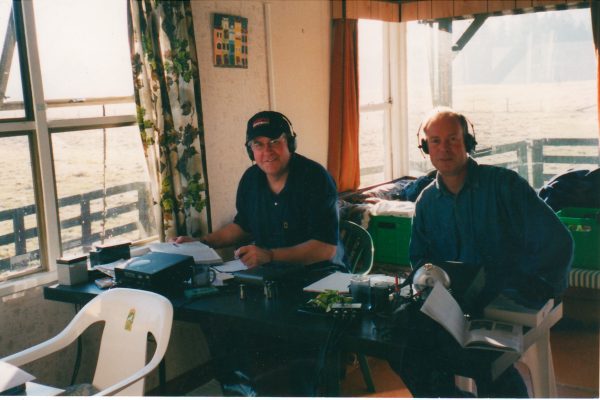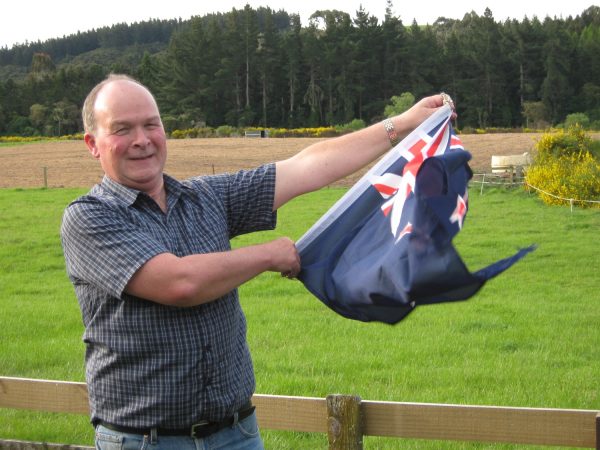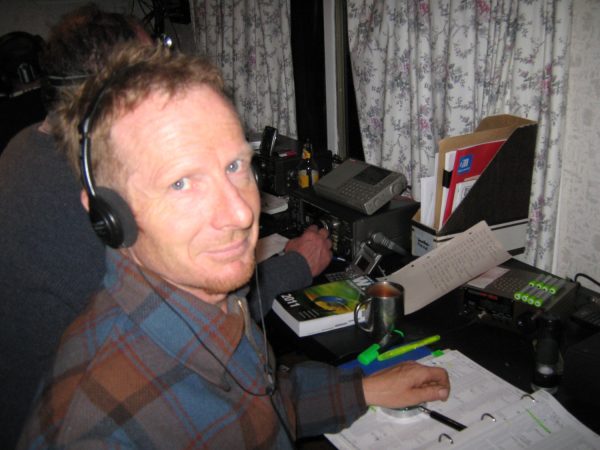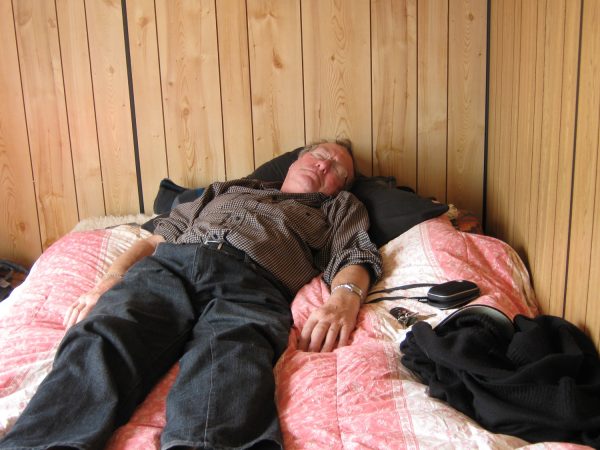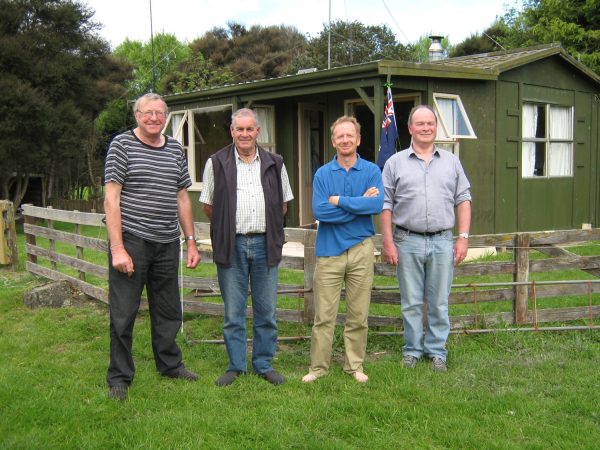Aerial view: Vertical aspect due North. Cabin denoted by red square .
THE GEOGRAPHY
Waianakarua – (pronounced “Wai-anaka-rua”), is a Maori phrase which means various things, one very apt meaning is “Between Two Rivers” and refers to the area in general. If you can find a map of Oamaru (which is approximately 100km North along the coast from Dunedin), Waianakarua is 20km south of Oamaru, and our cabin is 5km south of the township of Herbert and 7km inland. You reach it by traveling along Breakneck Road (nothing like as treacherous as it sounds!) and then turning left at the T-intersection down Reid’s Rd almost until you run out of road… then it’s 300 metres up a track into a paddock.
The area is a basin, surrounded on all sides by hills and cliffs and rather contradictory to the idea that being close to the sea is best for DX. There is a steep bank running right above the South side of the property, not too far from the cabin, which has a pronounced attenuating effect on stations from the city of Dunedin, only 90 km to the South. The north branch of the Waianakarua River defines the boundary of the area as it snakes it’s way between high banks and cliffs, with the paddock sitting above and sloping eastwards towards a very high cliff. There is a lot of native trees and plants and plenty of bird-life, fantails, bell-birds and the odd tui. There are very few fish in the river, only ever seen one trout and one eel though there are several flounder. There is a significant number of ‘pests’, namely rabbits and opossums plus a few ferrets and feral cats, though no dangerous insects, snakes or other nasties save for the occasional sand-fly, which although considerably smaller than a mosquito, delivers an unpleasant bite.
Waianakarua from the South-West
THE PROJECT
Back in 1981, my mother’s cousin asked us if we’d like a bit of land to build a cabin on. My father was a builder and worked in a factory pre-cutting anything from patio furniture right up to houses. Off we went for an inspection of the area, looking for suitable sites. The land was part of a farm that had proved only fit for grazing sheep on, being covered in tussock and undulating, split from the rest of the farm by a steep bank to the South about 40 metres high. The best feature was it’s proximity to the Waianakarua River and some good swimming holes. The area we had to chose from was divided by a muddy creek that often became stagnant and we realised we could never rely on it for a supply of drinking water. Nevertheless, a rise next to the creek surrounded on 2 sides by native bush provided ample room for the cabin and a fenced yard to keep out the sheep etc. I was alert to the possible potential of the area for DXing, considering that the nearest neighbour was a kilometre or more away… though the 110kV power-liners in the adjacent paddock about 300 metres from the site we had chosen did cause a bit of concern… more about them later…
So, back to the pre-cut factory, working evenings and weekends to produce a pre-assembled cabin. My father is one of those clever types who can produce an intricate plan in his head, and the cabin was no challenge. Unfortunately, his aptitude for working with wood didn’t filter down through the gene-pool to me! I was able to offer expertise in the wiring department, being a registered electrician and brother Wayne, a sheet-metal worker, was very handy to have around too. We all pitched in including brother Steve, with my mother, sister Sharon and my fiancée Linda providing sustenance and the finishing touches.
The cabin is some distance from the nearest power supply, the 110kV lines were part of the national grid. So a 12-volt set-up was the only option… this meant a few less creature-comforts but a very rustic life-style. The battery is a deep-cycle type (after throwing out countless standard car, truck and even bulldozer lead-acid varieties) and trickle-charged by a 22-watt solar panel. There is also a petrol-generator set using a Villiers pump motor, car generator & regulator. Water is rain-derived, taken from the guttering and stored in large tanks. We have a gas refrigerator and gas cook-top with a griller. There is a multi-purpose small wood-burning stove which provides heat and cooking as well as an LPG gas heater, kindly donated by the North Otago Branch of the NZRDXL. There is also a solar water-heater panel but it’s very rudimentary and only works when there’s plenty of sunlight… back to the drawing-board on that one! A cell-phone has supersceded a CB set for communications and the lack of a lap-top is could possibly be rectified in the future.
Lighting has until recently been a concern. The 12-volt incandescent standard lamps were 60 watts – any lower power produced a poor lux level, though they drew 5 amps and were a drain on the limited battery resources. Gas lamps were noisy though certainly bright enough and flourescents created a lot of QRM. I even used candles on occasion but with the advent of 12 volt halogen lighting, I can get ample light from just 20 watts and can highly recommend them for any portable operation too…
EARLY DX
There was an opportunity to test the area’s DX-potential one weekend. I took my Kenwood R-1000 mobile and hooked up a nearby fence as an aerial… the results were rather disappointing and I wasn’t holding out too much hopes of the site proving good DX-material.
Building the cabin went smoothly with the exception of when it came to digging holes for piles, fence posts etc as the ground was very stony. All was finished in time for Easter of 1982 and my parents were the first to stay there. I had booked in for May, a month before Linda and I were married. My plan was for a long weekend of three nights, taking the Friday off work and for plenty of SW DX, after all, the first test had shown MW to be bad and SW a little better. Undaunted, I decided that a Beverage aerial was still worth erecting so it was to be my main aerial. I arrived late morning and proceeded to run out a wire down in the area my compass told me was Lima (allowing for magnetic corrections). The wire was 350 metres long and averaged 1.2 metres high. I finished putting it up and then went back to the cabin, set up my receiver, tape-recorder etc then tuned into the 60mb.. hmmm… Latin signals everywhere. I tuned around for 20 minutes or so, pleased with the number and strength of the signals before dropping down to 90 metres, quite a few Latins there too… so around 0300 I tuned into MW… first frequency tried was 1580, signs of VOA in English, a few strong Latins nearby… too strong I thought… curses! my Kenwood R-1000 was over-loading and producing SW spurries! Then an id or two and things clicked into place… spurries – rubbish! VOA 1580 was from Antigua! So followed three nights of tuning from one channel to another, continually being very surprised and amazed… mostly Colombians though plenty from elsewhere too. I had no idea this was going to happen and logged 30 stations over the 3 nights. On the Saturday, veteran local DXer Peter Grenfell turned up only to be confronted with the same scenario… stations everywhere… I don’t think Peter logged a single station that night, he was a little over-whelmed with the number and strength of signals too…
And I discovered that those power-lines weren’t going to be too much of a problem for MW anyway. On a damp, drizzly night you could discern a background buzz, however on SW the noise would totally wreck reception of anything but the strongest stations. On one occasion, they had been creating considerable noise for a couple of days and the next day was the R St Helena broadcast. In desperation we went to the very opposite end of the paddock, close to a kilometre away and threw an aerial up into the trees… and they were still creating havoc! Next day’s reception of St Helena was subsequently spoilt though I’m happy to report better reception in later years. And I was very pleased when I heard that the power-lines would be dismantled as the cost of upgrading them was prohibitive with other lines many kilometres away being reconfigured to take the load. So since 1995, SW has not been plagued by that dreaded buzz!
AERIALS, AERIALS & MORE AERIALS
Plans for extra Beverages in different directions were advanced, thankfully some were permanent thanks to handy trees and bush, the first Latin aerial passed over tracks and grazing land so to this day, it has remained temporary. In September 1983, the first North American aerial was strung across trees and a corner of the adjacent paddock, across the Waianakarua River, over a real rough peice of ground covered with all sorts of nasty prickly plants like briar, black-berry, bush-lawyer & gorse. The bearing is about 75 degrees which made it ideal for Mexicans and the East-Coasters, particularly Florida. Mark Nicholls was visiting and I’m not sure if he would have come known the amount of sweat and blood he would have exuded putting up the aerial! It remains till the day and has a second aerial alongside.. every now and then, one or the other comes down and it’s back to that cursed bit of land with a slasher and gorse knife to get the aerials up again.
From the East. Looking from the cliff above the Latin aerials back up the paddock to the cabin
Alaskan stations have always been an attraction and I needed an aerial in their general direction. Firstly, I could only muster 165 metres first constructed in 1985. This produced a few of the stronger stations like KNOM 780, KFQD 750 & KYAK 650 but I needed something a bit longer. On an angle of about 20 degrees from the cabin, there is a couple of gullies within 40 metres, easy to overcome with my 4 metre surf-caster fishing rod, then a 150 metres of over-grown gulch running about parallel with the intended wire direction, also covered with the aforementioned plants. A bit of aerial ‘fishing’, sweat and effort produced an aerial approximating 250 metres, the rewards for which were some lower-powered Alaskans and plenty of Hawaiians.
Next up was a wire aimed at the West Coast of the USA, and a bearing of 50 degrees. This wire crossed trees and the adjacent paddock and a bit more fishing took it over the corner of totally impenetrable scrub-land absolutely covered in gorse… an army patrol could be lost in there for days! Then across the Waianakarua River into some willow trees to a termination and earth-stake. This wire had never been very successful, even when I added another 100 metres in the reverse direction. Terminating the opposite end has since given me an aerial which is effective for Middle-East and European signals coming on a near-polar route before sunrise.
I really needed a permanent Latin aerial so the placement of trees etc was looked at. The Waianakarua River ran in roughly the right direction so Mark Nicholls and Bryan Clark were “volunteered” into erecting a 600 metre aerial which ran down the Southern side of the aerial, travelling for a great part over trees, dropping down to a river flat, across more impenetrable scrub. At the Latin end of this aerial was a cliff of about 40 metres, so we walked the wire straight down the middle of the river for about the last two thirds of it’s length, then climbed the cliff, fished the end of the wire up to the top of the cliff and strained the wire as much as possible, dragging it across to the South over the river-flat.. Then the “volunteers” would go into the scrub as far as possible, poking the wire above the bush and the strain was adjusted as the wire straightened. This task took all day so it was with some anguish that we discovered it wasn’t working too well! The temporary aerial ran rings around it… after all that effort we weren’t about to rip it out so it was left in place. I thought it may be too close to the 40 metre cliff at the end so after 12 months and then Mother Nature forced my hand… a flood ripped out 200 metres of the wire… so I replaced it… then a small scrub-fire incinerated it… so I changed tack and ran it along the top of the paddock in trees… it was about 425 metres in total.. would it be any good? Yes!! Have made some exceptionally good logs on it since. It still isn’t as good as the temporary 475 metre wire which is dead straight, but it ain’t too far away from it.
Mark Nicholls & I after dragging the wire down the river.
One of the difficulties in getting into the paddock where the cabin was, is that when it rained a lot of water congregated in a natural channel where the road/track was. The muddy creek would break it’s bank up from the cabin and a new creek would appear very quickly… I nearly got bogged several times so a new approach to the cabin was needed. This ran alongside a fence… with tanalised wooden posts and Number 8 wire. It’s potential as an aerial was quickly utilised though it did need a short temporary section from where the fence stopped 40 metres short of the cabin. It is on a bearing of 355 degrees and is very good for Pacific, Japanese and Korean stations… unfortunately for New Zealanders too… the majority of which are North of Waianakarua… still, it’s been a valuable aerial and has produced a number of Japanese stations even some peaking over co-channel New Zealanders. One point of interest, the top wire which is used as the aerial, is fastened to the tanalised (a chemical treatment to ensure long-life in timbers buried in the ground) posts by metal staples. Andy Gardner suggested on one of his visits that the chemicals in the posts may cause some conductance to ground… a quick check with the multi-meter revealed he was correct so we fashioned some insulation from coax cable to isolate the wire from the timber and succeeded in substantially lowering the overall resistance of the aerial.
I used to have 4 x 45 metre dipoles as a concession to SW only I found that the Beverages worked better. As a result they are no longer, well I should say that they are ‘longer’, as I have converted them. One, now an aerial intended for the Caribbean and Central America which crosses the Waianakarua River to the top of a cliff of around 30 metres. It was only 170 metres so I wasn’t holding out much hope for it… and it proved rather ineffectual. I decided to experiment with adding another 100 metres off the receiver end and it proved much more useful… so much so that I logged both the 60-watt Dallas-Fort Worth TIS stations on it! Two of the others became the basis for a new aerial which was fed roughly mid-point and bearing 65 degrees, for a total length of 230 metres. This aerial also proved useful and whilst not up to the standard of the two 75 degree 300 metre aerials, was a good alternative if I was pushed for aerial selection. In March of this year, the back-lobe section was removed and another section added to the ‘front’ to take it out to 250 metres.. all pointing in the forward direction towards the USA and it’s value has increased. At this point, that summarises the aerial selection though I should also note that the 10 metre vertical mast which holds the TV aerial is also an aerial though rather sporadically used. I have12 sockets on my aerial board, two of which are unused.. though I have plans for the other two…
THE RECEIVERS
Over the years there have been many different brands of receiver adorning the tables at Waianakarua. I started with a Kenwood R-1000 and soon modified it by removing an attenutation section and adding a Radio West 1.9kHz filter. It stood up well against the Sony ICF-6800W and even the Icom ICR-70, and ran rings around the various Yaesu & Lowe receivers. In 1985 I swapped the R-1000 for a Drake SPR-4 and have been using the same set ever since. When you’re running on battery, any set that draws an amp or more places a fair amount of stress on the battery supply and the relatively high minimum operating voltage of some sets was also a problem as the batteries output voltage started to drop – the SPR-4 draws very little and still percolates well down below 9 volts! The Drake R-8 draws an amp when it’s switched off(!) and 2 amps when it’s running, so fine set that it may be, it needed a set of batteries of its own and at least one good top-up over a week. The R-5000 recievers impress too, running around an amp and also with improved MW performance when modified. The ICR-71 and NRD-535 are great sets too… but I was still left wondering what I would do if the trusty SPR-4 expired, short of buying another one… until Bryan Clark arrived with his AOR 7030+… a superb little machine that looked inocuous yet delivered substantial signals in a wide number of situations, so much so that an AOR 7030+ would be the top of my receiver shopping list.
Just as well it wasn’t Drake hunting season…
A word about coax and baluns etc… for may years my Beverages at Waianakarua were fed by open wires, I fashioned some rude aerial switches using bolts and alligator clips… the biggest draw-back was interaction between receivers using both the same and different aerials. Suddenly you’d lose a station because someone else had connected to a different aerial of changed from MW to SW etc… bit of a pain but heck, we never came to blows over it. My answer to that problem was to put up another aerial hence there are now four aimed at the USA, one at Central America/Caribbean and two for South America. Generally I can accommodate three DXers without too many aerial-sharing hassles though splitters are under consideration.
I read about baluns and built a few using toroidal cores from a New Zealand firm… they weren’t to the specification I wanted and ended up performing poorly, so it was back to open wires! Then I read about Shawn Axelrod & John Bryant’s success so decided to follow their pattern methodically and imported some balun cores from Amidon in California. This brought great results… no more interaction, tighter aerial patterns and better signal transfer I’m sure. The baluns are fitted at the head of the coax then run back to a metal box close to the receivers and are terminated on BNC sockets. Receivers are connected via leads with BNC plugs on and for ease of connection, the lugs are filed off either side of the sockets (thanks for that tip – and the sockets, to Andy Gardner).
After 17 years of DXing from Waianakarua, the the luxury of directional Beverages to negate interference from New Zealanders and Aussies was suddenly not enough. I was getting to the stage were I needed another edge and had played around with an R-L-C phasing unit as made popular by USA DXer Mark Connelly. I was finding some succes with the unit though finding reports from overseas DXers about the merits of the MFJ Enterprises units had me wondering how effective they might be. Invercargill DXer Steven Greenyer was very pleased with the results of his MFJ-1025 phaser (MFJ-1025 review) and I expressed interest in one myself. Thanks to Steven and fellow DXer Arthur Williams, I was able to pick one up from a ham operator’s deceased estate (MFJ-1026 review). Suddenly the phaser opened up new opportunities not only by being able to phase out interfering New Zealand stations but also by being able to combine two Beverages and getting a signal gain! Now there is a Superphaser, heralded even more highly than the MFJ so I’m sure I haven’t come to the end of the add-ons yet!
THE “VOLUNTEERS”
And I’ve had the company of many DXers over the years. Mark Nicholls has been a regular, as has Bryan Clark and Harry Weatherley who has made the journey several times from Australia. Others to spend a night or two at the dials include Andy Gardner, Tony Magon, Chris Martin (also from Oz) and Steven Greenyer. Many others have dropped in for an evening and several local DXers can be found escaping their local QRM, the most regular are Basil Jamieson, Peter Grenfell and Ray Davey.
Mark Nicholls, Harry Weatherley and yours truly…
DX SUMMARY
Europe:
MW: There are two paths open to Europe. Around the solar minima long-path Europeans make the journey around sunset which often coincides with sunrise in Europe thus giving a true Greyline enhancement. Europeans are on 9kHz spacing just as we are, and there are not very many clear channels in NZ now. 1107, 1323 & 1485 are the best chances yet when the long-pathers are really strong, like in 1996, they will be easily heard over NZ stations. The locals are also not very strong at this time of the day and Australian stations don’t fade in for another couple of hours. The other path is the opposite with sunrise here and sunset in Europe though it’s very rare to hear Europeans via this path nowadays as they need to be able to climb over strong New Zealanders and Australians.
SW: Europeans are very well heard here with many sub-50 watt European pirates making the trip.
Africans:
MW: Without a doubt, Africans are the hardest to hear. The propagation paths are very similar to Europeans only the signals pass much closer to the Poles and suffer heavily from any auroral activity, especially from anywhere South of the Sahara.
SW:Things are different, reception best in our mornings with some excellent tropical-band openings around our sunrise and early evening Western Africans heard most the year round, with a short trans-polar opening into Southern Africa possible mid-Winter from 0430-0530z (4:30 – 5:30p.m.). I’ve thought that the latter is a possible MW propagation path but so far, nothing has materialized.
Middle East:
MW: Only one propagation path here… around our sunrise though they can be heard at lower levels around an hour prior. Saudi Arabia 1440 used to be an early-bird though 2 New Zealanders on 1440 now make that less likely. A combination of the Equinox and solar minima has resulted in signals from Jordan, Yemen, Syria & Saudi Arabia flattening NZers at times.
SW: The Middle Eastern stations romp in here, best on the higher frequencies mid-afternoon and lower freqs through early and mid-morning.
Asia:
MW: One propagation path but a long one. Asians first fade in around 3 -4 hours after local sunset depending on the time of year and will be present right through to our sunrise.
SW: Our proximity to Asia means reception is possible for 24 hours a day… a similar reception pattern to the Middle East.
Pacific:
MW: Strangely enough, South Pacific stations don’t feature strongly down here. May have something to do with where their hops bounce but it isn’t often we get good, steady strong signals from our Pacific neighbours. There are some good early morning openings around 2-3 hours before sunrise for northern Pacific stations like Guam and Hawaii but it’s very seldom that we ever hear South Pacific stations outside of our evenings.
SW: A little like MW in that Kiribati, when active, should romp in here even if it is 500 watts though it took me quite a number of years to hear it. Unfortunately there are fewer and fewer Pacific SW stations on air now.
Alaska & Hawaii:
MW: Two good times to hear these are mid-evening and mid-morning. The latter coinciding with their sunrise, arounnd 2 – 5 a.m. and after all 10kHz channels have been vacated by daylight fade-outs of Canadian & US stations.
SW: Both KWHR and KNLS are very strong here though the latter can be subject to ionospheric fade-outs.
USA & Canada:
MW: On MW, we’re very lucky to be not only geographically situated in a good spot for reception especially from the Americas, but also from a timing point of view. A typical days DX is to arrive a couple of hours before local sunset and, depending on the season either target North Americans in the Summer, South Americans in the Winter or both around the equinoxes. We get steady reception of American signals until their local sunrise. And that’s it for them until the next day as there is no other propagation path. I’ve been fortunate enough to hear 43 US States and would dearly love to hear them all …
SW: Good from around 2000z (8a.m.) right through the evening till mid-night. Plenty of US pirates have made it over the years…
Mexicans:
MW: We get prolonged periods when Mexicans totally dominate the dials during our evenings… 1kW Mexicanos can clean out usually-dominant 50kW US stations with regularity. A lot of NZ DXers consider them pests however I enjoy their various musical styles and QSLing as many different States as possible is a target of mine.
SW: R Educacion is a potent signal here though aside from XERMX, XEOY and the rare appearance of R Huaycocotla, there isn’t a lot of activity.
Central Americans:
MW: I’m not sure what it is about Central Americans… they’ve never been that good! Ever now and then a window will open for a short length of time. Really strange as Mexicans are usual fare! I’ve heard every Central American country but nothing into double-digits for some obscure reason. They’re best around sunset here and their sunrise too though the odd mid-evening window is just as likely to pop up.
SW: Whilst MW Central Americans are relatively poor, their SW counterparts aren’t. Traditionally good signals are heard.
Caribbean:
MW: Why is it I wonder that Central Americans are so poor and Caribbeans are so good? Best reception times are around our sunset and their sunrise with few heard between. Some nights the Caribbeans are very dominant and I wonder if water take-off is the reason? Cubans aren’t as good as they used to be… I remember when you could hear la Voz de Cuba on nearly every channel from 550 to 700kHz…
SW: Though there aren’t many Caribbeans on SW these days, they have also been a regular force and no trouble to hear. Listening to R Grenada relaying test cricket on the 19 mb around 2100 (9a.m.) back in the late 70’s was a real treat.
South America:
MW: Of all the geographical categories, Waianakarua delivers South Americans best of all… and if you stood at the West end of the Latin Beverages and looked directly down the wire, you’d wonder how on Earth could they get past those hills and cliffs to the East! I’ve heard 100 Colombians, 50 Peruvians, 40 Venezuelans and 30 Chileans though only half a dozen Ecuadorians and two Bolivians. Argentines, Brazilians, Uruguayans and Paraguayans are the real treats and I’ve heard plenty of them too! Guyana is the only South American country I haven’t heard. In mid-Winter, the Latins can be heard from around 0300z (3p.m.) up till the last Peruvian fades out around 1100z (11 p.m.).
SW: Very similar reception patterns to MW except that in mid-Winter, signals from Brazil can be heard on the 60 m.b. 5 hours before sunset! Even though Brazil is the eastern-most country, for some reason their signals are very powerful here, 31 and 25 metre-banders can be heard from 2000z (8a.m.) past 1100z (11p.m.).
Basil Jamieson, regular visitor with John Lund from Denmark behind.
Peter Grenfell, another regular… both Basil & Peter use Kenwood R-5000s which percolate very nicely.
A regular occasion at Waianakarua, no, I’m not fishing… the fishing rod comes in very handy when stringing wires over tall trees and the various prickly and inaccesible bush…
Bryan Clark let me try out his new AOR-7030+… I was very impressed, a real performer.
Inside the cabin… generally a state of organized chaos
Bit of veterinary care for an injured Drake… I wonder what’s inside an AOR7030+???
And DX hasn’t been the only attraction… Andy Gardner was aiming at the side of a barn, missed and shot this unfortunate rabbit who was just hopping along minding his own business
And there is a very challenging 9-hole private golf course nearby. Bend your knees Bryan!
And to give you some idea of what I mean by challenging, there is a flag just visible through those trees… it’s called the “Ten Cents” as that’s how much room you have to aim through off this formidable tee..
MW DX HIGHLIGHTS
Over the years, Waianakarua has provided some outstanding MW DX… chronicled by highlights of the years as follows:
1982
R Paradise, St Kitts 825; YVWP R Apolo 1320 1kW; RFO Cayenne 1070; HCRO3 Ondas Orenses, Machala 915 1kW; VOA Antigua 1580; TGK R Cultural 1240; HJKX R Mundial 1370 1kW; OBX4J Estacion X 985 5kW;
1983
WIBW Topeka KS 580; HJPX R Olimpica 1480 1kW; HJTY Ondas del Carare 1410 1kW; OBX4D R Reloj 1520 1kW; FRO Martinique 1310; 4VEF Cap Haitien 840; 4VGA R Metropole 1280; 4VRS R Soleil 1170; WIOD Miami 610; WOW Omaha 590; OAX1C R Delcar 1520 1kW; HCCS5 R Calidad 1445 5kW; KTXZ West Lake Hills TX 1560 2.5kW; Caribbean Beacon, Anguilla 690; WXVI Montgomery AL 1600 1kW; KOLT Scottsbluff NE 1320 1kW; KSJB Jamestown ND 600; CBJ Chicoutimi PQ 1580; KDKA Pittsburgh 1020; WOKB Winter Garden FL 1600
1984
LRA R Nacional 870; KUAM Agana 612; RRI Surabaya 855; RRI Jember 963; LRA23 R Nacional 910; WIXO Mobile AL 1360; CBC Bridgetown, Barbados 900; WKJB Mayaguez PR 710; R Belize 834; JBC James Hill, Jamaica 790; HRKN La Voz de Olancho 705; HTC555 R 19 de Julio 555; KNOM Nome AK 780; KCJJ 1560 1kW; WSUN St Petersburg 620; CBK Watrous SK 540; R Trinidad 610; WPTF Raleigh NC 680; HOL80 R Nacional 840; V of Barbados 790; HRXX R Rumbos 1304 1kW; KYAK Anchorage AK 650; KFQD Anchorage AK 750; KICY Nome AK 850; KGTL Homer AK 620; WSIX Nashville TN 980;
1985
DW Cyclops 1566; R Moscow, Vinnitsa 1548; WDR Langenburg 1593; Yemen 1188; HIAQ R Amanecer 1571; CW1 R Colonia 550; CX16 R Carve 850; LR6 R Mitre 790; LU2 R Bahia Blanca 840; LRA16 R Nacional, La Quiaca 580; ZYK278 R Gaucha 600; LR1 R El Mundo 1070; ZYK522 R Record 1000; LR3 R Belgrano 950, LRA7 R Nacional, Cordoba 750, LU14 R Provincias 830; LU20 R Chubut 580; LW1 R Universidad 580 (three Argies on 580kHz!), WKJB R Reloj PR 580; CJBC Toronto ON 860; WABC New York 770; LR9 R America 1190; LV16 R Rio Cuatro 1010; SBC Sarnen, Switzerland 1566; WREC Memphis TN 600; Dominica 595; R St Vincent 705; KHAR Anchorage 590; HCMB2 Voz Porteña 1425 0.5kW; TGMU Union R 1302; OAX1N R Ideal 1410 1kW; HCBO5 R Espectaculo 905 1kW; HOL— R Nacional, Bocas del Toro 1015; KSON San diego CA 1240 0.489kW; TWR Monte Carlo 1467; R Luxembourg 1440 (long-path); CBR Calbary AB 1010; WTIX New Orleans 690; CBW Winnipeg MT 990; WGTR Fort Myers FL 1440 1kW;
1986
KGGF Coffeyville KS 690; CX20 R Monte Carlo 930; WJR Detroit MI 760; R Rani, Surinam 914; Caribbean R Lighthouse, Antigua 1165; JBC Old Harbour 850; KBYR Anchorage 700; KIAK Fairbanks 970; ZYK694 R Globo 1100; LS10 R del Plata 1030; LS6 R Buenos Aires 1350; LU14 R Provincias 880; HOU84 R Belen 1175; KFAR Fairbanks AK 660, KCSY Soldotna AK 1140; LR2 R Argentina 1110; KDLG Dillingham AK 670; ZDK Antigua 1100; YSS R Nacional 655; R Belize 830; CFGM Richmond Hills ON 1320; CBA Moncton NB 1070; HOL82 R Nacional 1080; ZGBC Dominica 1060; Emis Villa Verde, Macau 735; R Caribbean, St Lucia 840; RAI R Uno 1575; HOH4 Ciruito RPC 580 & 610; KIYU Galena AK 910; KRSA St Petersburg 580;
1987
TGRH R Horizontes 1480 1kW; TGKL R Emperador 910; CKRM Regina SK 1320; ZYJ458 R Globo 1220; LRI209 R Mar del Plata 670; LRA27 R Nacional, Catmarca 730; LS4 R Continental 590; RFO St Pierre et Miquelon 1375; KPEN Homer AK 620; ZYK205 R Farroupilha 680; ZYJ455 R Tupi 1280; JBC Kingston 560; ZYI420 R Vila Real, Cuiaba 590 5kW; LV1 R Colon 560; LU16 Emis Atlantico 1120; CX8 R Sarandi 690; CX30 La Radio 1130; CX4 R Rural 610; LS1 R Municipal 710; LRA24 R Nacional, Rio Grande 640; LRA21 R Nacional, Santiago del Estero 1130; TDF Lille 1377; SWF Rheinsender 1017; DDR Burg 1575; ABBS St Johns, Antigua 620; LRA15 R Nacional, San Miguel de Tucuman 1190; LRA2 R Nacional, Viedma 1150 1kW; LRA4 R Nacional, Salta 690; LRA6 R Nacional, Mendoza 960; LV9 R Salta 1160; Bulgaria 1161; Romania 153 & 855; TDF Rennes 711; CX28 R Imparcial 1090; ZYJ459 R Mundial 860; ZP36 R Ypoa 996; TDF Allouis 162; ZYJ453 R Jornal 940; CA156 R Parinacota 1564 0.5kW; CJCL Toronto ON 1430; EFJ15 Barcelona 1107; RNE Murcia 855; TDF Strasbourg 1161; RCE Valencia 1314; Lao National R 580; WAVG Loiuseville KY 970;
1988
XEBCO Colima 1210; WSMB New Orleans 1350; KLBS Los Baños 1330 ).5kW; WSZA Yap 1494
1989
WDAF Kansas City, MO 610; WXOK Baton Rouge 1460 1kW; WRXB St Petersburg FL 1590; WMBM Miami Beach FL 1490 1kW; CHLO Toronto ON 1570; CJOY Guelph ON 1460; WBRD Palmetto FL 1420 1kW; WDAE Tampa FL; WQIK Jacksonville FL 1320; WMT Cedar Rapids IA 600;
1990
KWES Colorado Sprongs, CO 1460 0.5kW; KKOA Kearney NE 1460 0.5kW; KAMA El Paso 750 1kW; WYFX Boynton Beach FL 1040 1kW; OAX4K R Imperial 1444 2kW; V6AK Chuuk 1593; WNWZ Germantown TN 1430 2.5kW;
1991
WQXR New York 1560; KATL Miles City MT 770 1kW; KSPE Santa Barbara CA 1490 1kW; KLOG Kelso WA 1490 1kW; OBX3D R Ancash 1516 3kW; OBX5D R Andahuaylas 1060; TILXX R Columbia 1160
1992
WRXJ Jacksonville FL 930; WFLA Tampa FL 970; XEAR La Mexicana, Tampico 660 0.5kW; CC145 R Libertad 1450; ZGBC Dominica 740; R Caraibes Int, St Lucia 1090; CB93 R Nuevo Mundo 930; LS3 R Splendid 990; CB127 R Festival 1270; CJVR Melfort SK 1420; WKXY Sarasota FL 930; WERC Birmingham AL 960;
1993
HCJB1 La Vozde los Andes 690; CP1 R Nacional, La Paz 1390; R Muz, Ukraine 1431; R Thailand, Ranong 1593; R Ulan Bator 164; WAGL Lancaster SC 1560;
1994
Vatican R 1611; JOXR Okinawa 783; Asgabat 1125; VOA Belkize 1530 & 1580; ZJB Montserrat 885; Caribbean Christian R, Turks & Caicos 1020; Jordan 1494; Turkey 1062; 4VRL R Liberte 1360; KXO El Centro 1230; R St Lucia 660; JBC Port Maria 750; SER R Linares 1602; RNE5 Teruel 1107; WTOP Washignton DC 1500; KIRL St Charles LA 1460 0.5kW; CJME Regina SK 1300; KLTC Dickinson ND 1460
1995
WAOZ Cincinnatti OH 1360; CC68 R Nueva Ines de Suarez 860; RNE Arganda 1359; KUSA1600 Las Vegas 1660; AIR Nagpur 1566; JOAR Nagoya 1053; HJZE R Estrella 1510 1kW; WFFG Marathon Key FL 1300; XEACC La Voz del Puerto 870 1kW; SER Alcoy 1485
1996
WJDM Elizabeth NJ 1660; WANM Tallahassee FL 1070; WAMR Venice FL 1320; WTMY Sarasota FL 1280 0.5kW; V of Nevis 895; ZP1 R Nacional 920; LV3 R Cordoba 700; V of Russia, Wachenbrunn 1323; WWFE Miami FL 670; Deutschlandfunk, Heusweiler 1422; TDF Limoges 792; R Eviva, Beromunster 1566; SER Santander 1485; DW Mt Angel 702; NOZEMA Flevoland 747; SER Sevilla 792; R Euzkadi, Vitoria 963; WRNE Gulf Breeze FL 980; RNE San Sebastian 774; RDP Terceira, Azores 693; XEPC Zacatecas 890 1kW;
1997
KSIX Corpus Christi 1230; R Baku, Azerbaijan 1296; V of Russia, Moldova 1467; WQA767 Dallas-Fortworth 1640 & 1680 0.06kW; RTVA Ouargla, Algiers 198; ZYJ754 R Guaruja 1420; ZYK537 R Capital 1040; LT3 R Cerealista 680; Yemen 760; WGN Chicago Il 720; Vietnam 783; CBM Montreal PQ 940; Al-Kharanah, Jordan 207;
1998
WPHG Atmore AL 1620; R Esmeralda, Buenos Aires 1620; LS11 R Provincias 1270; R Vision Cristiana, Turks & Caicos 530; R 12-70 Aruba 1270 1.5kW; 4VSJ R Antilles 1240; WMDM Lexington Park, MD 1690; WJNZ Ada MI 1680;
1999
WTDY Madison WI 1670; WHKT Portsmouth VA 1650; LRI200 R Puerto Deseado, 740 1kW; CX24 R Nuevo Tiempo 1010; WQSN Kalamazoo WI 1660; WRNC Warner-Robins GA 1670; LRL202 R Diez 710; WKSH Sussex WI 1640; WMIB Marco Is FL 1660; ZP14 R Nanduti 1020; CB157 R Famila 1570; WTTM Princeton NJ 1680;
2000
LT9 R Brigadier Lopez 1150; CX32 Radiomundo 1170; LS5 R Rivadavia 630; R Tropical, Buenos Aires 1620; ZYJ453 Sistema LBV 940; R Buen Aire, Buenos Aires 1630;
2001
WLEO Ponce, Puerto Rico 1490; WGIT Canovanas, Puerto Rico 1660

